Miami County History Pass
The Miami County History Pass takes you on a journey to local museums, historic sites, murals and sculptures. Be inspired, be educated, and become connected to the people, places, and events that make Miami County such an important part of Ohio – and America’s – history.
Check out our prizes HERE.
Questions? Here are the FAQs!
History Pass Participating Locations
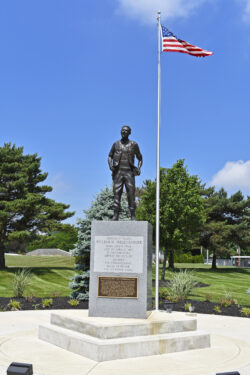
1421 South St, Piqua, OH 45356
William H. Pitesenbarger was born in Piqua in 1944, Pitesenbarger flew almost 300 rescue missions during the Vietnam War to aid downed soldiers and pilots. He was killed on April 11, 1966 after helping save the lives of over 60 men in battle. Pitsenbarger could have been rescued but stayed on the ground to help the 20 infantrymen still alive and “waved-off” the helicopter. Pitsenbarger was originally awarded the Air Force Cross, but on December 8, 2000, at the National Museum of the United States Air Force, the airman’s father, accepted the Medal of Honor on William’s behalf. He was the 59th Medal of Honor recipient and sixth enlisted recipient. The movie, The Last Full Measure, released in 2019, centers on the true story of this Vietnam War hero. In 2020, Pitsenbarger was inducted into the Dayton Region Walk of Fame.
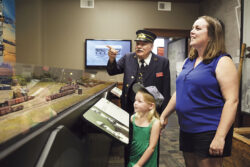
200 N Miami Ave, Bradford, OH 45308
The railroad came to Bradford in 1857 when the first train reached the end of the railhead at the Miami/Darke County line. Being an important junction between connecting rail terminals, most trains passing through Bradford changed crews here. Bradford became known as a “railroad town” and the railroad was seen as the dominant industry for many years. This small community in western Miami County is proud of its railroad history and still celebrates it to this day. This museum is dedicated to the preservation of Bradford’s railroad heritage. The museum has also restored Bradford’s Pennsylvania Railroad BF interlocking tower, which is located at 501 East Main Street.
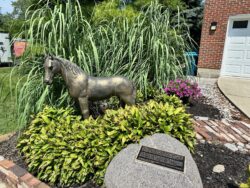
7 N 4th St, Tipp City, OH 45371
According to legend, Col. Daniel Rouzer lived in Tippecanoe and rode his horse to battle during the Civil War. They both survived and returned home. When the horse passed away and was buried, Rouzer apparently had a clause placed in his will: nothing was to ever cover the horse’s grave.
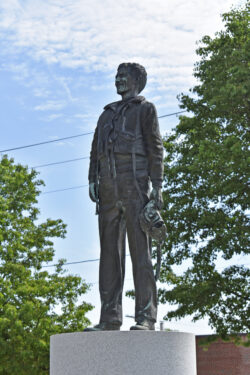
237 E High St, Piqua, OH 45356
Dominic Salvatore Gentile was a World War II USAAF Pilot, known as the “Ace of Aces” because of his number of air and ground kills. He was born in Piqua in December 1920 and enlisted in 1941. By April 1944, he was the Air Force’s leading ace with 27.8 enemy planes destroyed in the air and on the ground. He was killed in January 1951 during a training exercise near Andrews Air Force Base.
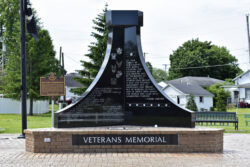
8660 OH-66, Piqua, OH 45356
Located in a two-acre citizens’ commemorative park for local veterans lies an eight-foot Indiana black granite monument listing over 160 names of Piqua citizens. This memorial was dedicated in 1993 and pays tribute to the men and women who gave their lives fighting for freedom. The memorial also includes 4,000 dedication bricks honoring U.S. veterans.
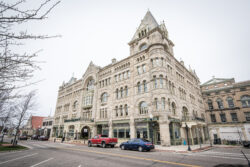
308 N Main St, Piqua, OH 45356
Built in 1891, the Fort Piqua Plaza has been an icon of history for over 130 years. This hotel played host to many prominent people including Teddy Roosevelt and William Howard Taft, who both spoke from its balcony during their campaign tours in 1912. This beautiful Late-Victorian style building is now home to the Piqua Public Library and a grand banquet center.

6476 U.S. Hwy 40, Tipp City, OH 45371
Gale Halderman, born and raised in Tipp City, was the designer of the original Ford Mustang and worked for Ford Motor Company for over 40 years. Gale passed away in 2020 at the age of 87, but his story lives on through his personal collection of items from his life and career at Ford. You will be awed at this museum as you peruse wall-to-wall, floor-to-ceiling exhibits, including historical photos, original drawings, posters, awards, and an extensive collection of other memorabilia dedicated to this iconic automobile. Visits to the museum are by appointment only.
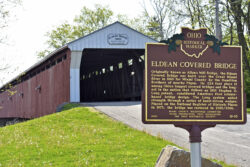
Eldean Rd &, N. County Rd 25A, Troy, OH 45373
Built in 1860, Eldean Bridge is the longest “Long Truss” covered bridge in the country, spanning 224 feet and is one of only two covered bridges remaining in the county. Its historical significance earned it a spot on the National Register of Historic Places in 1975, and in 2016, it was further honored as a National Historic Landmark.
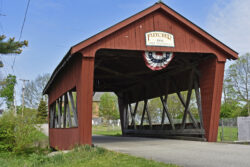
59 Church St, Fletcher, OH 45326
Dedicated in 1998, the Fletcher covered bridge is a new look at an old style of bridge design. Visitors to the bridge can get a taste of the simple life while visiting this historic re-creation.
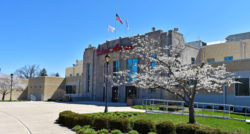
255 Adams St, Troy, OH 45373
Hobart Arena has been bringing events and entertainment to Troy and the region for more than 75 years. From hockey to ice skating, graduations and home building events to nationally known performers and cheerleading, Hobart Arena has become a strong community-oriented venue hosting a variety of events for decades.
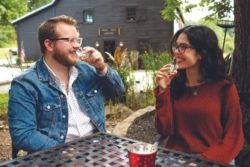
7095 Staley Rd, New Carlisle, OH 45344
A “true sip of history”, Indian Creek Distillery whiskeys are uniquely small batch where art, science and heritage combine to produce a spirit like no other. Using the original Staley recipe and the oldest copper pot stills in the country, their award-winning Legendary Ohio Frontier Whiskeys are created with a passionate dedication to authenticity – slowly and thoughtfully crafted.
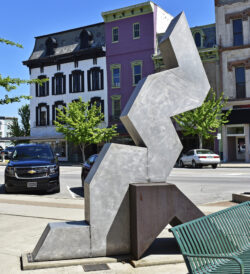
16 S Walnut St, Troy, OH 45373
Jacob’s Ladder was created by Ukranian sculptor, Aka Pereyma. Pereyma spent much of her life in Troy, and for ten years, she was the artist coordinator for the Welding for Artists Program at the Hobart School for Welding Technology. The symbolic stairway of Jacob’s Ladder projects diagonally upwards. According to Pereyma, “It makes you look up to heaven, or should feel like you want to climb higher.”
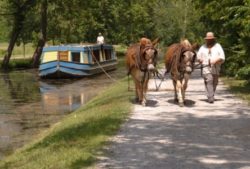
9845 N Hardin Rd, Piqua, OH 45356
Johnston Farm & Indian Agency celebrates 2000 years of Ohio’s rich history from prehistoric Indians to Ohio’s canal era while honoring John Johnston – farmer, public official, and U.S. Indian Agent for western Ohio from 1812 to 1829. On a visit to Johnston Farm, guests will enjoy a ride on The General Harrison, a replica 70-foot-long canal boat, drawn by mules, which at the time was used to haul passengers and cargo along the Miami and Erie Canal. In addition, John Johnston’s home and the museum provide a glimpse of what it was like on the frontier during this time. Costumed guides on the boat and farm provide an authentic and memorable experience back in time.

510 W Water St # 210, Troy, OH 45373
The Local History & Genealogy Center serves over 4,000 researchers a year from all over the country looking for information on family history and historical documents from the Miami County area. The center features books, maps, manuscripts, wills, land records, a microfilm/fiche catalog, public computers, digital resources, knowledgeable researchers, and unique artifacts, such as a Congressional Medal of Honor from the Civil War. Our staff also provides programs to the community–at the libraries and in various locations–making history come alive.
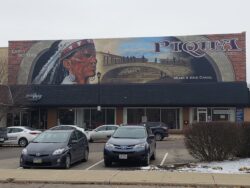
101 E High St, Piqua, OH 45356
This 20 x 80 foot mural in downtown Piqua was created by Eric Henn of Franklin, Ohio. The mural pays tribute to Native Americans who once called Piqua home and the impact of the Miami-Erie Canal on the area.
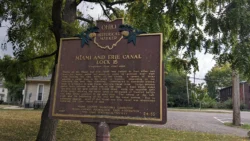
Canal Lock Park, Tipp City, OH 45371
This section of the Miami and Erie Canal, constructed from 1833-1837, was vital to this region’s commerce and development. It allowed farmers and businesses to get their goods to larger markets at a lower cost and faster speed than by hauling overland. John Clark saw the location of Lock 15, situated in Monroe Township at the junction of the Milton-Carlisle Pike (Main Street), as an opportunity and in 1840, platted the new town of Tippecanoe City (now Tipp City). Some of the original buildings still stand, such as a mill to the west of Lock 15, John Clark’s home at the Southeast corner of Main and First Streets, and the hotel at the northeast corner of Main and Second Streets. Travel on the Miami and Erie Canal was limited to four miles per hour for boats pulled by mules in order to prevent boat wash from eroding the clay banks of the canals. A system of locks allowed a canal boat to be raised or lowered, depending on the direction the boat was traveling. Constructed of limestone blocks, Lock 15 is typical of most Miami and Erie Canal locks. Large wooden gates were located on each end of the lock. A boat would enter the lock and the gate behind it would close, while the opposite gate would open, allowing the water level to be raised or lowered before the boat could proceed to its next stop. The advent of the railroad was the beginning of the end for the canal system. Due to extensive damage, most of the Miami and Erie Canal was abandoned following the Great Flood of 1913.
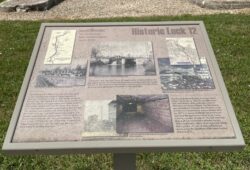
409 N Elm St, Troy, OH 45373
Construction of the Miami extension of the Miami and Erie Canal, which included Troy, began around 1834. Lock 12 was built in 1836. General William Henry Harrison and other dignitaries officially opened the Troy section on July 4, 1837. The canal brought prosperity to the area, as its products were shipped to new markets and more people moved here. The last canal boat came through Lock 12 in 1912 and the disastrous flood of March 1913 finally ended Troy and Ohio’s canal era. Evidence suggests that in the late 1920s, the Hobart Brothers Company’s building on West Main Street covered part of the lock. The building and lock were razed in 2015. The footprint monument was dedicated June 7, 2017, and includes stones from Lock 12.
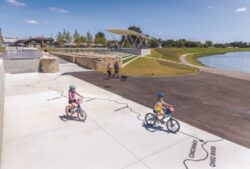
125 E Water St, Piqua, OH 45356
Completed in 1837, the limestone lock nine served as a catalyst for the growth of Piqua. The lock helped connect the village of Cincinnati (1837) and Toledo (1845) by way of the Miami and Erie Canal. German immigrants traveled up the canal from Cincinnati and settled within a five-block area of the lock. Industries used the lock as a source of water power and developed products as diverse as flannel, flour, and flax seed. Lock nine remained as a functioning part of the canal until its destruction during the flood of 1913.
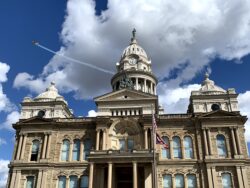
215 W Main St, Troy, OH 45373
Completed in 1888, the courthouse stands as one of the tallest structures in the county, towering 185 feet above the Great Miami River and is fitted with a copper statue of Lady justice with bronze statues in attendance. It was designed by architect Joseph Yost of Columbus, Ohio and was placed on the National Register of Historic Places in 1975.
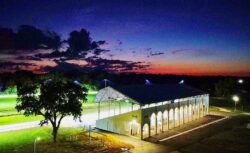
650 N County Rd 25A, Troy, OH 45373
The Miami County fairgrounds in Troy, Ohio date back to 1846 when the fair was first established on Troy’s east side. The fairgrounds moved to its current location, on 25A, in 1871 and the grandstands were built in 1912. The grandstands were renovated in 2023 and are the perfect space for many events that take place at the fairgrounds today.
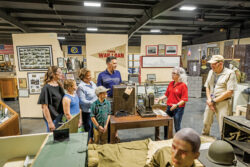
2245 S Co Rd 25A, Troy, OH 45373
Serving a seven-county area, the five-acre Miami Valley Veterans Museum is a long-term repository for artifacts, photos, over 200 veterans’ interviews in their Research/Multimedia Center and other objects of significance to veterans and their families. Museum exhibits reflect time periods from 1745 to the present day and focus on all branches of the military.
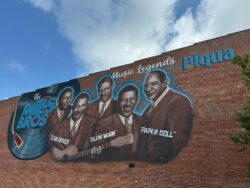
195 N Main St, Piqua, OH 45356
The Mills Brothers were pioneers of the African American music scene. The vocal jazz quartet was born and raised in Piqua until they moved to New York City in the 1930s to start their music career. The Mills Brothers became the first African American singers to have their own radio show, “Four Boys and a Guitar”. The group sold over 50 million copies of more than 2,000 recordings. The Mills Brothers mural is a great way to honor the legacy of these Piqua musical legends.
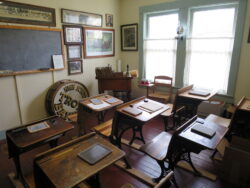
124 E Water St, Troy, OH 45373
A rich history of Troy, Ohio is housed in the restored pre-Civil War home of John Kitchen where rotating displays depict life in Troy and Miami County between 1850 and 1950.
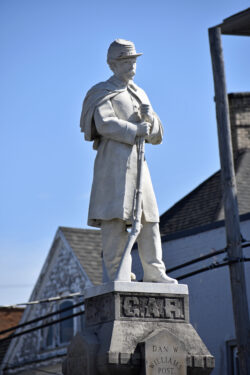
2 S Main St, Pleasant Hill, OH 45359
This sculpture is dedicated to the 13 fallen heroes who died during the Civil War. Their names are engraved on the base. An identical Civil War statue is in Troy’s Riverside Cemetery.
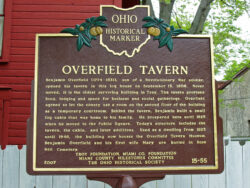
201 E Water St, Troy, OH 45373
1808 was a time when the small settlement of Troy, Ohio was on the great frontier. This tavern was a gathering place for social and government purposes and is now open tot he public as a museum featuring a collection of late-18th to early-19th century artifacts. The two-story Federal style square-hewn log building has survived as the oldest building in Miami County and one of the oldest in Ohio and is on the National Register of Historic Places.
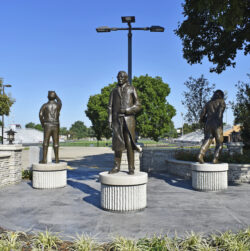
134 N Market St, Troy, OH 45373
The Pioneers of Aviation is a Sculpture Garden featuring Clayton Brukner, Robert Hartzell & Dr. Nancy Currie-Gregg. The first in the trio of statues is Clayton Brukner who was the president of WACO Aircraft and started the Brukner Nature Center. Hist statue stands 8 feet tall and helps celebrate the members of Troy’s Aviation history. The second statue is of Robert Hartzell. Hartzell founded Hartzell Walnut Propeller Company. The final statue is NASA astronaut Dr. Nancy Currie-Gregg who has flown four space missions.
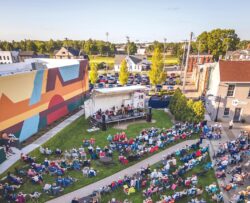
Prouty Plaza, 1 W Main St, Troy, OH 45373
Ukrainian American artist, Aka Pereyma’s artwork is visionary and expressive. She weaved folk-art traditions with modern artisti styles. Designed by Aka Pereyma, “Sunrise Sunset”, the mural located at Prouty Plaza, uses different colors and shapes that make for a colorful, fun, and funky background.
![]()
1400 Tyrone Rd, Troy, OH 45373
Trinity- Trinity is an example of minimal art showing the integral relationship between the three separate but equal cubic forms. This sculpture was created in 1975 by sculptor Mike McConnell and is all Cor-ten steel. A native of Troy, McConnell has exhibited his work throughout the United States.
Weldicon- Weldicon was created in 1968 by sculptor Gluseppe Pino Spagnulo. It was donated to the Miami County Park District form the collection of the Hobart Institute of Welding Technology. Weldicon is one of Spagnulo’s early metal works.
Eclipse- Created in 1970 by sculptor, Aka Pereyma, and donated to the Miami County Park District from the collection of the Hobart Institute of Welding Technology, this sculpture is made of steel. Eclipse is strategically placed at Hobart Urban Nature Preserve to show the relationship between nature and art.
Split II- Split II was created by Charles Ginnever in 1973 and is constructed of 1/4″ Cor-ten steel. This sculpture explores the illusions created by actuality and perceptions. This three-dimensional illusion looks much deeper than the actual depth.
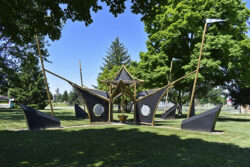
Troy, OH 45373
A 20th century interactive sculpture, created in 1992 by Michael Bashaw, Sound Chamber was created for the Hobart Brothers’ 75th anniversary. This hands on piece was inspired by the concept of musical ceremonial structures like those of North Sumatra and Bali, with outlets for spontaneous making of sounds and art. It is meant to be played by all.
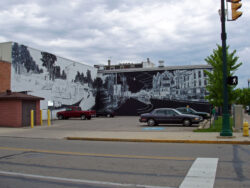
11 N Market St, Troy, OH 45373
There are two murals on the exterior walls of the Troy Rec depicting scenes of historical Troy. One mural is of a canal boat on the Miami and Erie Canal, and the other is an early 20th century Troy street scene. The design for the murals came form illustrator Tim Bowers, and the scenes were painted by Troy High School art students in 1974 under the supervision of then-art teacher Delmar Preston. After some deterioration, Dan Keyes and his son Patrick, repainted the scenes in August 2014.
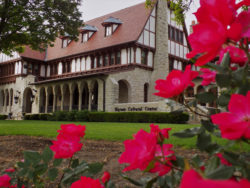
301 W Main St, Troy, OH 45373
The Hayner mansion was built in 1914 by Mary Jane Hayner, whose husband owned the Hayner Distillery Company. Hayner now serves as the arts and cultural center of the community, featuring art, photography, historical exhibits, concerts, and other cultural programming.
The Troy-Hayner Cultural Center also houses the premier United States collection of Hayner Distillery artifacts and ephemera. The collection includes over 100 bottles and jugs spanning more than 56 years of manufacturing with dozens of varieties of spirits, products and marketing items. In 1866, Lewis Hayner built a distillery on Water Street in Troy and founded “Lewis Hayner, Distiller, Pure Copper Distilled Rye and Bourbon Whiskies.” Hayner Distillery expanded with the country’s industrial revolution and fell away with the threat of impending prohibition. The distillery on Water Street was shut down in 1920.
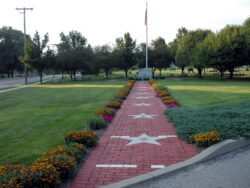
Riverside Cemetary
101 Riverside Dr, Troy, OH 45373
A Veteran’s Memorial near the front entrance of Riverside Cemetery honors our military men and women. There are memorial pavers on the walkway around the monument for fallen veterans.
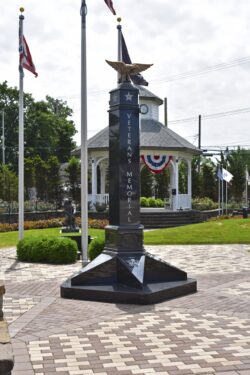
450 W Main St, Tipp City, OH 45371
The Tipp City Veteran’s Memorial Park is a tribute ot all United States military veterans. The park includes a gazebo and memorial paver bricks. These brick pavers surround the monument and contain the names of local veterans dating back to WWII.
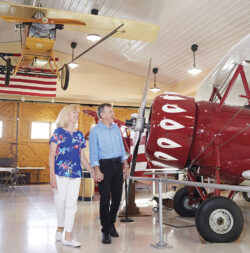
1865 S Co Rd 25A, Troy, OH 45373
The Weaver Aircraft Company (WACO) was the largest manufacturer of civil aircraft in the US in the late 1920s and early 1930s. Today, at this historic field and museum, you can take a flight in WACO’s biplane “Sunny”, to see beautiful Miami County from the sky. In addition, WACO offers a wide range of learning opportunities. With a mission to educate and inspire students and adults who have a passion for flying, WACO has developed programs around science, technology, engineering and math as it relates to aviation.
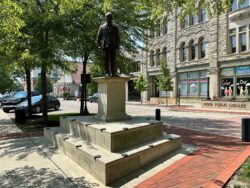
147 High St, Piqua, OH 45356
William Moore McCulloch was a lawyer who was instrumental in leading the civil rights movement in Ohio and a key figure in the passage of the Civil Rights Act. He was a member of the Ohio House of Representatives from 1933-1944, serving as minority leader from 36-39 and speaker from 39-44. He introduced the comprehensive civil rights bill in 1963, together with representatives John Lindsay and Charles Mathias. McCulloch was recognized by Kennedy’s successor, Lyndon B. Johnson, under whom the act was passed, as “the most important and powerful political force” in passing the act.

